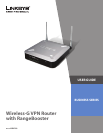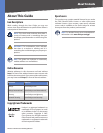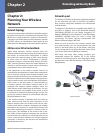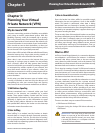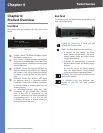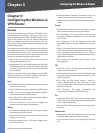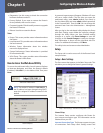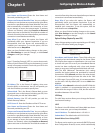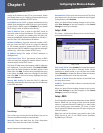
2
Networking and Security Basics
Wireless-G VPN Router with RangeBooster
Chapter 2
Chapter 2:
Planning Your Wireless
Network
Network Topology
A wireless local area network (WLAN) is exactly like a regular
local area network (LAN), except that each computer in the
WLAN uses a wireless device to connect to the network.
Computers in a WLAN share the same frequency channel
and SSID, which is an identification name shared by the
wireless devices belonging to the same wireless network.
Ad-Hoc versus Infrastructure Mode
Unlike wired networks, wireless networks have two
different modes in which they may be set up: infrastructure
and ad-hoc. An infrastructure configuration is a WLAN
and wired LAN communicating to each other through
an access point. An ad-hoc configuration is wireless-
equipped computers communicating directly with each
other. Choosing between these two modes depends on
whether or not the wireless network needs to share data
or peripherals with a wired network or not.
If the computers on the wireless network need to be
accessible by a wired network or need to share a peripheral,
such as a printer, with the wired network computers, the
wireless network should be set up in Infrastructure mode.
The basis of Infrastructure mode centers around an access
point or wireless router, such as the Wireless-G VPN Router,
which serves as the main point of communications in
a wireless network. The Router transmits data to PCs
equipped with wireless network adapters, which can
roam within a certain radial range of the Router. You can
arrange the Router and multiple access points to work
in succession to extend the roaming range, and you can
set up your wireless network to communicate with your
Ethernet hardware as well.
If the wireless network is relatively small and needs to
share resources only with the other computers on the
wireless network, then the Ad-Hoc mode can be used.
Ad-Hoc mode allows computers equipped with wireless
transmitters and receivers to communicate directly with
each other, eliminating the need for a wireless router or
access point. The drawback of this mode is that in Ad-
Hoc mode, wireless-equipped computers are not able to
communicate with computers on a wired network. And, of
course, communication between the wireless-equipped
computers is limited by the distance and interference
directly between them.
Network Layout
The Wireless-G VPN Router has been specifically designed
for use with both your 802.11b and 802.11g products.
Now, products using these standards can communicate
with each other.
The Wireless-G VPN Router is compatible with all 802.11g
and 802.11n adapters, such as the Notebook Adapters
(WPC4400N, WPC200) for your laptop computers, PCI
Adapter (WMP200) for your desktop PC, and USB Adapter
(WUSB200, USB1000) when you want to enjoy USB
connectivity. The Router will also communicate with
Wireless Ethernet Bridges (WET200).
When you wish to connect your wireless network with
your wired network, you can use the Router’s four LAN
ports. To add more ports, any of the Router’s LAN ports
can be connected to any Linksys Business Series switch
(such as the SLM series or SRW series switches).
With these, and many other, Linksys products, your
networking options are limitless. Go to the Linksys
website at www.linksys.com for more information about
products that work with the Wireless-G VPN Router with
RangeBooster.
Network Diagram



